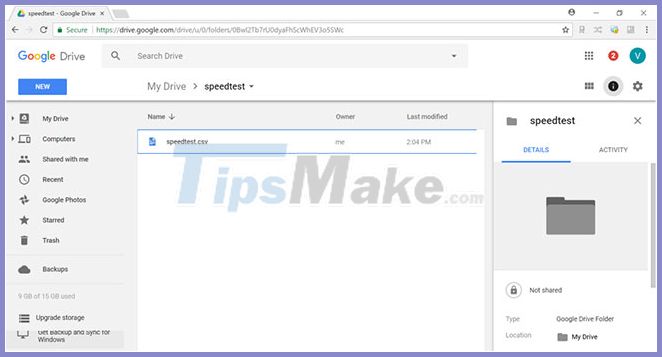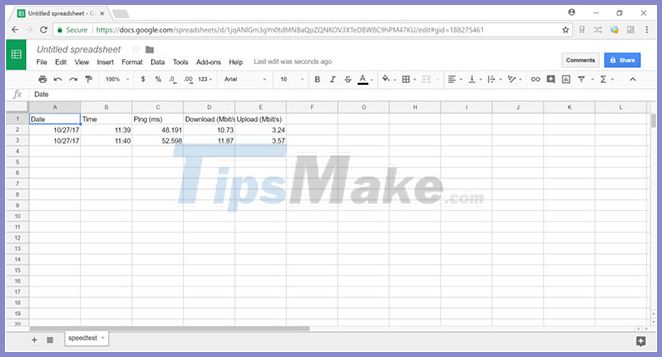How to use Raspberry Pi to monitor Broadband speed
Once you have the basics set up, you can automate monitoring of your broadband connection, so it continues for as long as you like.
A CSV file will be generated (comma separated values) into Google Drive and updated once an hour. CSV is a very simple file format that can be opened in Microsoft Excel or imported into Google Sheets. Sounds like a handy thing? This article assumes you have Raspbian installed on your Pi.
Use Raspberry Pi to monitor Broadband speed
Step 1: Check for updates
As always, start with checking for the latest updates. Run the following commands in Terminal:
sudo apt-get update sudo apt-get upgradeStep 2: Install speedtest-cli
There are different methods to measure a broadband connection speed. We'll use speedtest-cli , 'a command line interface for checking Internet bandwidth using speedtest.net'.
speedtest-cli is not available right from the Raspbian repository, but you can install it from the Python Package Index (PyPI). That's easily done using a tool called pip that comes pre-installed on Raspbian Jessie and Stretch. You can ensure that you have pips by running this command:
sudo apt-get install python-pipIf you get the message 'python-pip is the latest version', that means it's ready for use.
Next, use pip to install speedtest-cli:
sudo pip install speedtest-cliWith speedtest-cli now installed, you can measure your broadband speed easily with the following command:
speedtest-cliHowever, for the purposes of this article, it is more convenient to use the Simple mode of speedtest-cli:
speedtest-cli --simpleYou should see something like this:
Ping: 47.943 ms Download: 40.93 Mbit/s Upload: 2.33 Mbit/sHowever, that output does not follow the CSV syntax. Hence, you will need to parse the data and get it right.
Step 3: Create Python script
Let's create a new Python file:
sudo nano speedtest.pyHere's what you should have inside the file (you can of course copy and paste these lines):
import os import re import subprocess import time response = subprocess.Popen('speedtest-cli --simple', shell=True, stdout=subprocess.PIPE).stdout.read() ping = re.findall('Ping:s(.*?)s', response, re.MULTILINE) download = re.findall('Download:s(.*?)s', response, re.MULTILINE) upload = re.findall('Upload:s(.*?)s', response, re.MULTILINE) ping[0] = ping[0].replace(',', '.') download[0] = download[0].replace(',', '.') upload[0] = upload[0].replace(',', '.') try: if os.stat('/home/pi/speedtest/speedtest.csv').st_size == 0: print 'Date,Time,Ping (ms),Download (Mbit/s),Upload (Mbit/s)' except: pass print '{},{},{},{},{}'.format(time.strftime('%m/%d/%y'), time.strftime('%H:%M'), ping[0], download[0], upload[0])(Assuming you are saving the script in / home / pi / - otherwise just change the path here: if os.stat ('/ home / pi / speedtest / speedtest.csv'). St_size = = 0:) .
After you have the lines in the right place, you can save the file and exit the editor by pressing Ctrl + X, Y and Enter .
Script run speedtest-cli in Simple mode, parse the output and output it in CSV format. You can run the script with the following command:
python speedtest.pyAnd if you do, you should see a line like this:
10/26/17,10:18,47.943,40.93,2.33Step 4: Create a directory
Let's create a directory for the CSV file:
mkdir speedtestIf you're wondering why you need a folder for a file, it's because you'll sync that folder with Google Drive. Once synced, everything inside the folder will correspond to the content of the Google Drive folder.
Now, if you run your Python script like this:
python speedtest.py >> speedtest/speedtest.csv… You will have a CSV file with broadband speed data in the new folder.
If you check the contents of the file (e.g. cat speedtest / speedtest.csv ), you can see lines like this:
Date,Time,Ping (ms),Download (Mbit/s),Upload (Mbit/s) 10/26/17,10:18,47.943,40.93,2.33Step 5: Integrate the script with Google Drive
To integrate the script with Google Drive, you can use the Google Drive CLI Client of user GitHub Petter Rasmussen. Download its Raspberry Pi version by running the following command:
wget -O gdrive https://docs.google.com/uc?id=0B3X9GlR6EmbnVXNLanp4ZFRRbzg&export=downloadNext, let's specify file permissions:
chmod +x gdriveYou need to notify Google Drive to allow Google Drive CLI Client to connect to the account. It is possible to do so by running the Google Drive CLI Client with any parameters. For example, this command lists the contents of your Google Drive account:
./gdrive listYou should now see an authentication request like this:

Just follow the instructions: Visit the URL in your browser, log into your Google account and allow ' GDrive (…) to view and manage the files in your Google Drive. '(GDrive (…) view and manage your Google Drive files). Then you're ready to enter the verification code.
Finally, gdrive will list your Google Drive content.
Now that you have the speedtest folder on your Raspberry Pi, create a corresponding directory for Google Drive:
./gdrive mkdir speedtestThe program returns the ID of the new directory. Copy it, as you will need it later.
Next, let's sync the two speedtest folders:
./gdrive sync upload speedtest IDJust replace the ID with the speedtest directory ID.
If everything goes as expected, you should now see a folder called speedtest in your Google Drive. In the directory, there is a previously created file ( speedtest.csv ):

Now, if you run the Python script again, new broadband speed data will be added to the end of the file:
python speedtest.py >> speedtest/speedtest.csvAnd if you run the sync command again, you can see your updated file in Google Drive:
./gdrive sync upload speedtest ID(Again, remember to replace the ID with the ID of the speedtest directory).
 You can see your updated file in Google Drive
You can see your updated file in Google Drive
Step 6: Automate everything
All that's left is to make things work automatically. To do this, use cron, which makes it possible to schedule commands to run at specific times, such as once an hour.
Let's create a short shell script containing commands to run once an hour:
sudo nano speedtest-cron.shAdd the following familiar commands (Assuming you've done everything in the / home / pi / directory - otherwise just change the path):
sudo python /home/pi/speedtest.py >> /home/pi/speedtest/speedtest.csv /home/pi/gdrive sync upload speedtest ID(And, again, remember to replace the ID with the ID of the speedtest directory.)
Then save and exit with Ctrl + X, Y and Enter .
Please specify the permissions to execute the script:
sudo chmod +x speedtest-cron.shNow you are ready to test the script:
./speedtest-cron.shOkay, let's create the cron task:
crontab -eEnter the following line in the editor, save and exit by pressing Ctrl + X, Y, Enter :
0 * * * * /home/pi/speedtest-cron.shBroadband speed monitoring is now available. The results of the speed test will be recorded once an hour. You can open CSV files in Google Drive using Microsoft Excel or Google Sheets. If you prefer the following option, you will have to import the file ( File> Import… ).

You can open CSV files in Google Drive using Microsoft Excel or Google Sheets
You should read it
May be interested
- How to add an ADC to Raspberry Pi: What you need to know
 raspberry pi lacks analog input. this puts it at a disadvantage compared to microcontroller-based boards like the arduino.
raspberry pi lacks analog input. this puts it at a disadvantage compared to microcontroller-based boards like the arduino. - Raspberry Pi Zero vs Model A and B, how are they different?
 you want to buy a raspberry pi, but when you search, you have a problem: why are there so many raspberry pi models? although all of the different raspberry pi can do many similar tasks, there are tasks that specific boards will be more suitable for.
you want to buy a raspberry pi, but when you search, you have a problem: why are there so many raspberry pi models? although all of the different raspberry pi can do many similar tasks, there are tasks that specific boards will be more suitable for. - Everything You Need to Know About Overclocking the Raspberry Pi 400
 aside from the keyboard case, it's essentially a modified raspberry pi 4, using the same broadcom bcm2711 cortex-a72 quad-core processor. and, like the pi 4, you can overclock it if you feel the need for more speed.
aside from the keyboard case, it's essentially a modified raspberry pi 4, using the same broadcom bcm2711 cortex-a72 quad-core processor. and, like the pi 4, you can overclock it if you feel the need for more speed. - How to boot Raspberry Pi 4 from USB or over the network
 the raspberry pi is a wonderful, flexible piece of software, capable of a wide range of possibilities, from running a media center to using it as a radio.
the raspberry pi is a wonderful, flexible piece of software, capable of a wide range of possibilities, from running a media center to using it as a radio. - What is the Raspberry Pi and how is the Raspberry Pi used?
 you can use the raspberry pi as a computer because everything needed has been built in. its broadcom bcm2835 soc processor includes cpu, gpu, ram, microsd card slot, wi-fi, bluetooth and 4 usb 2.0 ports.
you can use the raspberry pi as a computer because everything needed has been built in. its broadcom bcm2835 soc processor includes cpu, gpu, ram, microsd card slot, wi-fi, bluetooth and 4 usb 2.0 ports. - How to start Raspberry Pi 3 from USB
 raspberry pi is a great, versatile software suite, with a variety of capabilities like running a media center or using as a radio.
raspberry pi is a great, versatile software suite, with a variety of capabilities like running a media center or using as a radio. - Why should people try Raspberry Pi 4?
 the new raspberry pi 4 has been released, but do you need to upgrade? is raspberry pi 4 really offering more features than the previous raspberry pi 3 b +?
the new raspberry pi 4 has been released, but do you need to upgrade? is raspberry pi 4 really offering more features than the previous raspberry pi 3 b +? - Raspberry Pi AI Kit: Bring AI to Raspberry Pi
 the raspberry pi ai kit is essentially raspberry pi's new m.2 hat+ board integrated with the hailo-8l acceleration module.
the raspberry pi ai kit is essentially raspberry pi's new m.2 hat+ board integrated with the hailo-8l acceleration module. - Learn Pi Imager, How to Use Raspberry Pi Imager
 the raspberry pi foundation recently released a new application for recording sd cards for the raspberry pi. the new program, called raspberry pi imager, launches march 5, 2020.
the raspberry pi foundation recently released a new application for recording sd cards for the raspberry pi. the new program, called raspberry pi imager, launches march 5, 2020. - How to use Raspberry Pi Imager to install Raspberry Pi OS
 raspberry pi foundation recently released a new app for burning sd cards for raspberry pi. the new program, called raspberry pi imager, launched on march 5, 2020.
raspberry pi foundation recently released a new app for burning sd cards for raspberry pi. the new program, called raspberry pi imager, launched on march 5, 2020.










 How to set up a USB WiFi Adapter on a Raspberry Pi
How to set up a USB WiFi Adapter on a Raspberry Pi 5 security tips for the Raspberry Pi
5 security tips for the Raspberry Pi How to turn a Raspberry Pi into a NAS with OpenMediaVault
How to turn a Raspberry Pi into a NAS with OpenMediaVault How to set up VPN Surfshark on Raspberry Pi
How to set up VPN Surfshark on Raspberry Pi How to turn Raspberry Pi into a Bluetooth speaker
How to turn Raspberry Pi into a Bluetooth speaker How to turn Raspberry Pi into a personal cloud server
How to turn Raspberry Pi into a personal cloud server